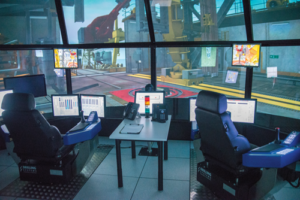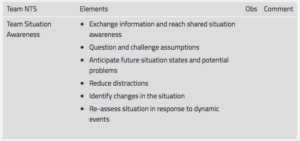To get the most out of drilling simulators, follow these 5 principles for designing training exercises
Focusing only on technical details of scenarios won’t allow organizations to maximize team performance
By Margaret Crichton, People Factor Consultants

As drilling simulators become increasingly more sophisticated and available, organizations are increasingly exploring the possibility of enhancing safety and team performance by carrying out exercises on full-scale high-fidelity drill floor simulators. The amount of effort being put in by companies and trainers is impressive. However, based on more than 200 observations of teams taking part in exercises on drilling simulators, it’s also been observed that organizations are not investing sufficiently in the design of simulator-based exercises that would provide the maximum benefit for the team and organization.
Too often, organizations assume that putting a team through a simulator-based exercise will be sufficient to modify or enhance the team’s safety and performance. Some organizations focus purely on the technical details of scenarios, and the team performance aspects are just assumed to occur as a by-product. Other organizations do not even realize that team interactions and decision making can be specifically targeted by exercise participation. A high-fidelity drill floor simulator is a tool, and how that tool is used can be variable. The simulator, at its most powerful, can be configured to allow both technical and non-technical skills to be practiced by making exercises immersive, achieving psychological fidelity, using realistic and varied scenarios, and increasing learning and reflection opportunities.
Based on these observations, a guidance has been prepared in the form of a “how- to” document. It presents five principles for designing simulator-based exercises for drilling teams (Crichton, 2017). This guidance was developed based on an extensive review of the experiences of the aviation and healthcare industries, which have drawn on simulator-based exercising for a number of years.
The first principle relates to identifying learning objectives and expected performance standards. This was found to be the main area that was overlooked when simulator-based exercises were being considered. For example, a number of organizations have not developed objectives other than “to give the teams the chance to exercise using the simulator,” while other organizations have developed learning objectives relating purely to specific technical aspects, such as to practice connections and tripping using specific procedures, or to rehearse using specific systems, such as managed pressure drilling (MPD).
While this is not necessarily a bad thing, it does not fully utilize the power of a simulator in allowing a team to rehearse operational practices, as well as to reflect on team safety and performance.
Team performance learning objectives, or expected performance standards, are seldom prepared for drilling teams. On the other hand, aviation, medicine and maritime have identified the expected behaviors and integrated cues to stimulate such behaviors into exercise scenarios, i.e., including information or cues to trigger situation awareness or decision making.
Technical competencies are generally developed within organizations, but only rarely are non-technical competencies that outline expected behaviors available. Yet these team knowledge, skill and attitude (KSA) competencies can be used for training and assessment purposes, consequently enhancing the team’s behaviors and safe working practices.
Principle 2 relates to training the team as a whole, although there are limits to the number of participants in any one session. Some organizations have sent teams of up to 15 members to take part in simulator-based exercises, but this interferes with the realism and benefits of the exercise. Too often, additional team members attend the exercise either to “see what goes on” or to “understand how the simulator is set up,” which then causes distractions for the participants when these attendees are not gainfully involved in the role play.

Sometimes these non-essential attendees do not understand why they are attending the session and, often unintentionally, affect the atmosphere of those attendees who want to become immersed in the scenario. Simulator-based exercises should be limited to those who would normally interact with the key roles on the drill floor, i.e., the driller and assistant driller. The learning objectives as described in Principle 1 should be used to identify the critical roles to attend the sessions.
Simulator-based exercises may be of value both to newly created teams, to allow team members to examine how they will work together, and to teams faced with a challenging section in the drilling plan that will allow team members to practice what may be relatively new or unfamiliar procedures. The aim is to encourage team members to use team non-technical skills, e.g. team situation awareness, team decision making, teamwork and communication, and team workload and stress management. Introducing these concepts to the team as a whole increases the probability of uptake of the concepts. It further encourages the team to integrate these concepts into their routine working practices. These non-technical skills then become integral to the functioning of the team in the workplace.
Simulator-based team training also overcomes the challenge of individual team members attending a training course and returning to the team setting enthused with new concepts or ideas, but no one else in the team appreciates or understands these concepts. For example, if an individual team member has attended a crew resource management type of training course and rejoins the team introducing phrases such as situation awareness, often this needs to be repeatedly explained to others, and the integration of the concept is diluted until gradually more team members either attend the same course or become familiar with the terminology.
Observations of simulator-based exercises attended by team members from one organization that was willing to embrace the concept of team training indicated that team members rapidly adopted these concepts during team discussions and interactions during the exercises. For example, team members would cite team situation awareness during pre-task briefings and during the exercises. There would be comments, such as “something is not quite right here… we may have to stop the job at some point and reassess the situation” or “call out when you hear or see anything different.” In teamwork and communication, if team members had not verified the information being exchanged, then there were comments such as “you need to let me know that you heard the right figure.” Effective verification emerged after feedback about the importance of confirming information exchanges, such as “SPP is 450” and “450, I got you.”
In Principle 3, the use of a structured observation tool aims to enhance team performance. Simulator-based exercises are typically facilitated by a qualified technical trainer, often supported by a qualified non-technical skills specialist. The technical trainer focuses on the technical aspects of the exercise, leaving the non-technical skills specialist to observe the team behaviors. A structured observation tool provides an objective framework to help capture and record behaviors, which reduces the potential for observations to become subjective.
The observation tool must be appropriate to the setting in which it is being used. For example, an observation tool for aviation is not suitable for a drilling team because roles, tasks and decisions are different. Therefore, the drilling team observation tool needs to be specifically developed and should describe the type of KSAs relevant to a drilling team.
At present, the status of simulator-based training for drilling teams means that most non-technical skills observations are carried out by non-technical skills specialists, if at all. The aim is to train technical trainers to use the tool to enable them to observe non-technical skills and to encourage teams to use the observation tool themselves at the workplace to reflect on team performance.
Tying in closely with the use of a structured observation tool is Principle 4, which describes the benefits of providing feedback during a structured debrief. There is little doubt that providing feedback on performance can help the team to improve by highlighting positive behaviors, as well as areas for improvement. For example, it has been found that team performance can improve by 20% to 25% following the introduction of debriefs.
One of the major benefits of simulator-based exercising is that teams can carry out a scenario and receive feedback on their performance. They can then repeat the same or a similar exercise to enact and test out any suggested improved behaviors. In this way, behaviors are reinforced. Suggested changes in behaviors need to be practicable and achievable, and the team needs to recognize the value in making the changes.
Ideally, teams should be encouraged to debrief themselves at the end of the exercise so that they develop the habit of reviewing performance. Observations have indicated that some teams were particularly enthusiastic about debriefing themselves, but it has been noted that other teams were much more negative about their performance than the non-technical skills specialist. In such cases, teams needed reassurance that their behaviors “met expectations” and feedback about modifications that could be implemented to raise the level to “above expectations,” which the team wanted to achieve.
Finally, Principle 5 refers to simulator-based exercising not being a one-off event. Instead, it should be repeated regularly to enhance expertise and retain performance standards, either high- or low-fidelity simulation. Introducing a relatively new set of concepts and terminology, such as team non-technical skills, takes time and motivation and requires reinforcement. A proposed way to increase acceptance of suggested changes in behaviors is to make simulator-based exercises highly immersive and, more importantly, enjoyable for learning. This means that the exercises need to be designed appropriately. Although both technical and non-technical information can be presented in the classroom, carrying out exercises on a simulator makes this information come alive and increases its relevance. Actual practice reinforces the learning, and training is more likely to be transferred to the workplace.
Training courses integrating simulator-based exercises incorporating both technical and non-technical skills typically last three to five days. This means that the team can take part in approximately three to five exercises, which can increase in complexity during the course. Initial observations of team performance can be fed back and improvements noted during the remaining courses – or not. Often, team members enjoy and benefit from the exercises and debriefing, with feedback from team members being very positive.
Simulator-based training was considered to represent a new approach in preparing crews (operator, contractor, and service organization personnel) for complex drilling programs, as well as building a team’s capabilities. For example, one team that undertook simulator-based training prior to spudding reported a positive effect of the focus on team non-technical skills, such as tool-box talks being more carefully and rigorously conducted, team members being conscious of the effects of distractions, especially on the driller and assistant driller, and contingencies and “what if” questions being asked more frequently. Team members also checked in with each other to ensure they are not overloaded and that roles and responsibilities are clear. Examples of comments from participants include that such training helps to expect the unexpected when drilling complex wells; getting more familiar with risks for each section through rehearsing on the simulator; and taking time to listen to other team members and share information effectively.
In conclusion, simulator-based exercises for drilling teams can be an extremely valuable, cost-effective and instructive technique for enhancing team safety and performance, both technically and non-technically. Increases in productivity and reductions in potential human error have been reported in teams that have carried out simulator-based training prior to beginning a drilling program. Improvements can be made about how these exercises are developed, which will increase the benefits that can be gained. DC
This article is based on a presentation at the 2017 IADC Human Factors Conference, 17-18 October, Galveston, Texas.





